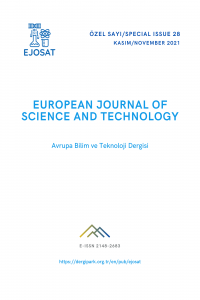Kademeli Gözenekli Doku İskelelerin Mekanik Davranışının Sonlu Eleman Analizi ile Tahmin Edilmesi
Öz
Eklemeli imalat olarak bilinen 3D baskı, uzun zamandır kullanılmaktadır. Eklemeli imalat bilgisayar yazılımı ve bilgisayar destekli tasarım (CAD) kullanarak 3B nesneler oluşturmasına izin vermektedir. 3D baskının mühendislik için artan kullanımı nedeniyle, basılı parçaların mekanik davranışını iyileştirmek için araç ve stratejilerin geliştirilmesi gerekli hale geldi. Kademeli gözenekli doku iskeleleri, kemik doku mühendisliği için oldukça önemlidir. Bu çalışmada, kortikal ve süngerimsi kemiklerin bimodal yapısına benzer kademeli gözenek yapısına sahip yeni bir hibrit doku iskele geliştirilmiştir. Doku iskelesi hibrit olarak tasarlanmış olup, 200-300-500 µm ve 200-500 µm olmak üzere üç ve iki kademeli gözenekte tasarlanmıştır. Doku iskelelerin gözenekliliği hesaplanmıştır. Mekanik davranışı simüle etmek için kademeli gözenekli hibrit doku iskelelerin stres analizi yapılmıştır. FEA sonuçlarına göre gözenekliliğin doku iskelelerin mekanik özellikleri üzerinde olumsuz etkiye sebep olduğu görülmüştür. Daha düşük gözenekliliği nedeniyle 200-500 µm-b hibrit doku iskelesi, FEA analizine göre en yüksek mekanik özelliklere sahip olmuştur.
Anahtar Kelimeler
Sonlu Elemanlar Analizi PLA FDM Gerlime Analizi Mekanik Özellik
Kaynakça
- Barletta, M., Gisario, A., & Mehrpouya, M. (2021). 4D printing of shape memory polylactic acid (PLA) components: Investigating the role of the operational parameters in fused deposition modelling (FDM). Journal of Manufacturing Processes, 61, 473-480.
- Shie, M. Y., Shen, Y. F., Astuti, S. D., Lee, A. K. X., Lin, S. H., Dwijaksara, N. L. B., & Chen, Y. W. (2019). Review of polymeric materials in 4D printing biomedical applications. Polymers, 11(11), 1864.
- Garg, A., & Bhattacharya, A. (2017). An insight to the failure of FDM parts under tensile loading: finite element analysis and experimental study. International Journal of Mechanical Sciences, 120, 225-236.
- Farbman, D., & McCoy, C. (2016, June). Materials testing of 3D printed ABS and PLA samples to guide mechanical design. In International Manufacturing Science and Engineering Conference (Vol. 49903, p. V002T01A015). American Society of Mechanical Engineers.
- Surmeneva, M. A., Surmenev, R. A., Chudinova, E. A., Koptioug, A., Tkachev, M. S., Gorodzha, S. N., & Rännar, L. E. (2017). Fabrication of multiple-layered gradient cellular metal scaffold via electron beam melting for segmental bone reconstruction. Materials & Design, 133, 195-204.
- Özeren, E., & Altan, M. (2020). Effect of structural hybrid design on mechanical and biological properties of CoCr scaffolds fabricated by selective laser melting. Rapid Prototyping Journal, 26(4), 615-624.
Estimating Mechanical Behavior of Scaffolds with Graded Porosity by Finite Element Analysis
Öz
3D printing, which is commonly known as additive manufacturing, was around for decades. It allowed users to create 3D objects using computer software and computer aided design (CAD). Due to the increasing use of 3D printing for engineering, the development of tools and strategies to improve the mechanical behavior of printed parts has become necessary. Scaffolds with gradient porosity becomes an attractive candidate for bone tissue engineering. In this paper, a novel hybrid scaffold with a graded pore structure similar to the bimodal structure of cortical and cancellous bones was described. The scaffolds were designed as hybrid, they had three and two grade as 200-300-500 µm, and 200-500 µm. Porosity of the scaffolds was calculated. Stress analysis of the hybrid scaffolds with graded porosity was carried out to simulate mechanical behavior. According to FEA results, porosity had negative effect on the mechanical properties of the scaffolds. Due to its lower porosity 200-500 µm-b hybrid scaffold had highest mechanical properties according to FEA analysis.
Anahtar Kelimeler
Finite Element Analysis PLA FDM Stress Analysis Mechanical Behaviour
Kaynakça
- Barletta, M., Gisario, A., & Mehrpouya, M. (2021). 4D printing of shape memory polylactic acid (PLA) components: Investigating the role of the operational parameters in fused deposition modelling (FDM). Journal of Manufacturing Processes, 61, 473-480.
- Shie, M. Y., Shen, Y. F., Astuti, S. D., Lee, A. K. X., Lin, S. H., Dwijaksara, N. L. B., & Chen, Y. W. (2019). Review of polymeric materials in 4D printing biomedical applications. Polymers, 11(11), 1864.
- Garg, A., & Bhattacharya, A. (2017). An insight to the failure of FDM parts under tensile loading: finite element analysis and experimental study. International Journal of Mechanical Sciences, 120, 225-236.
- Farbman, D., & McCoy, C. (2016, June). Materials testing of 3D printed ABS and PLA samples to guide mechanical design. In International Manufacturing Science and Engineering Conference (Vol. 49903, p. V002T01A015). American Society of Mechanical Engineers.
- Surmeneva, M. A., Surmenev, R. A., Chudinova, E. A., Koptioug, A., Tkachev, M. S., Gorodzha, S. N., & Rännar, L. E. (2017). Fabrication of multiple-layered gradient cellular metal scaffold via electron beam melting for segmental bone reconstruction. Materials & Design, 133, 195-204.
- Özeren, E., & Altan, M. (2020). Effect of structural hybrid design on mechanical and biological properties of CoCr scaffolds fabricated by selective laser melting. Rapid Prototyping Journal, 26(4), 615-624.
Ayrıntılar
| Birincil Dil | İngilizce |
|---|---|
| Konular | Mühendislik |
| Bölüm | Makaleler |
| Yazarlar | |
| Yayımlanma Tarihi | 30 Kasım 2021 |
| Yayımlandığı Sayı | Yıl 2021 Sayı: 28 |

